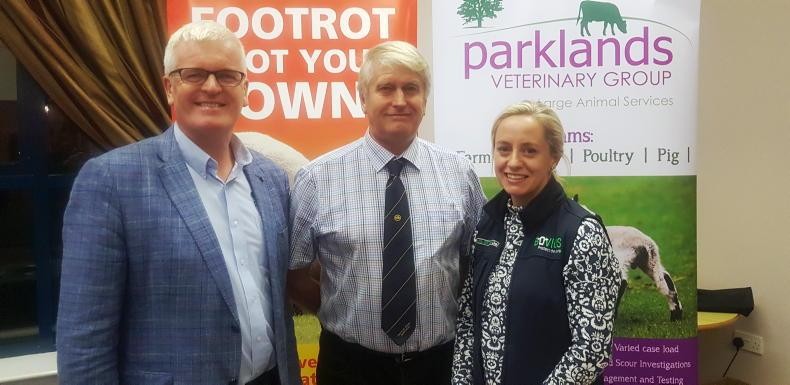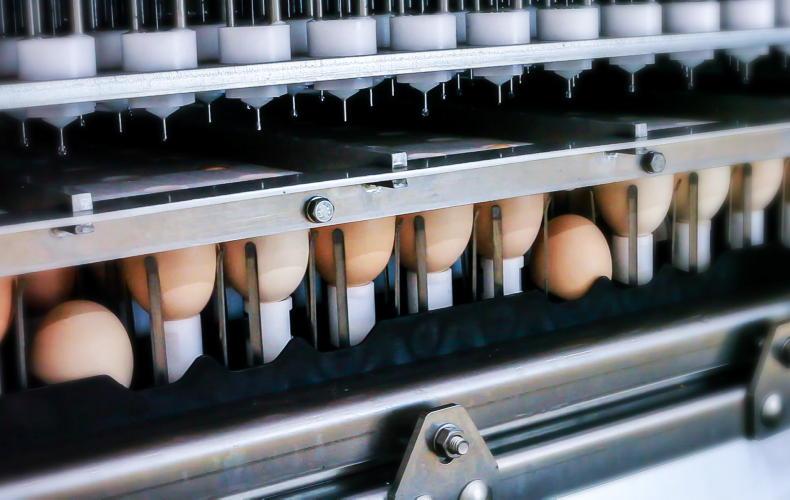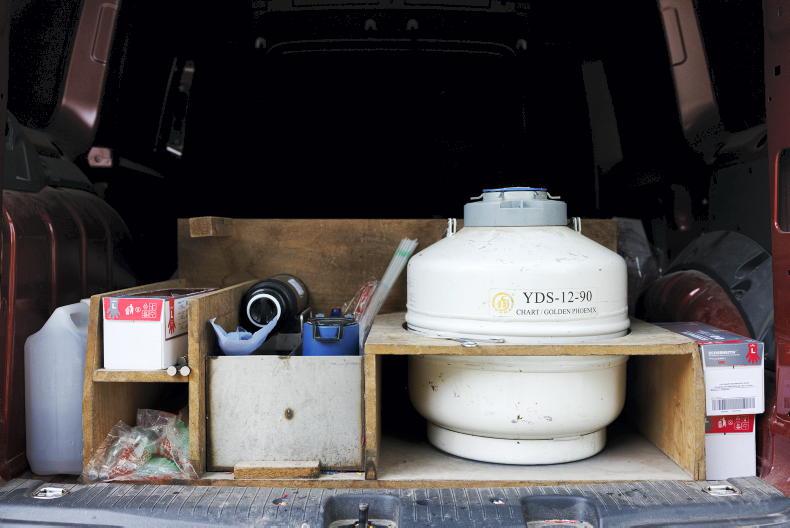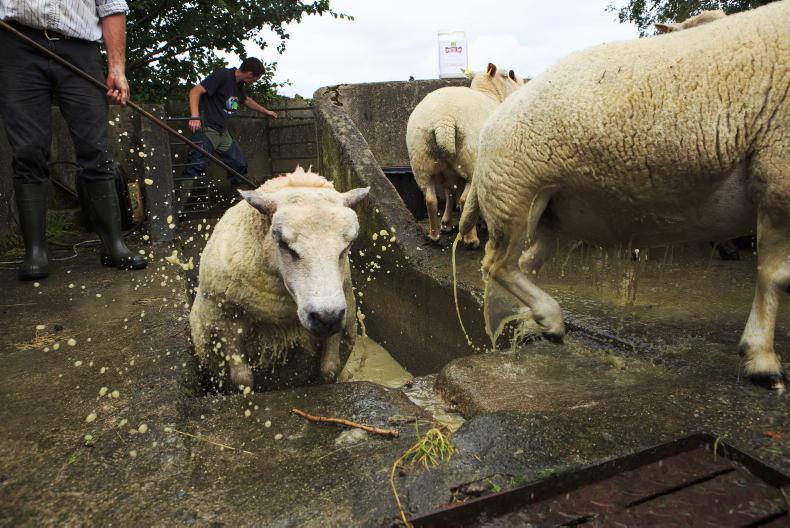Sheep farmers need to move away from relying on blanket treatments of wormers as their only means of controlling internal parasites, a local NI vet has said.
Speaking in Loughguille, Co Antrim, John Grant from Parklands Veterinary Group suggested farmers should weigh lambs every two or three weeks to identify those that are not hitting liveweight gain targets.
“We are going to have to move to a system where instead of treating hundreds of lambs at a time, we treat them as individuals based on their weight gain,” he said at the National Sheep Association (NSA) meeting.
Tracking growth rates in individuals requires lambs to be tagged at a young age and a reliable system needs to be in place for recording weights and calculating daily liveweight gains.
John said the use of an electronic identification (EID) tag reader and a software package for keeping records helps reduce the labour requirement for monitoring performance in individuals.
He gave the example of a sheep handling system developed by Jack and Nick Cotter from Co Limerick.
It includes a weighbridge with built in software which automatically records weights and tells the farmer if a lamb needs to be wormed or not.
John also said taking a dung sample and faecal egg count (FEC) from an individual lamb gives a much more accurate insight than taking a pooled dung sample from a large group. His general rule of thumb is that lambs with a FEC over 200 eggs per gram should receive a wormer treatment.
“If you sample a batch of 20 lambs, you could have some lambs with under 200 eggs per gram who don’t need a treatment. Other lambs could have over 1,000 eggs per gram and need to be wormed, but the average value for the group will be somewhere in the middle,” he said.
Resistance
The main benefit of using wormers in a more targeted way is the overall amount of product used should reduce, which means there is less opportunity for resistant worms to develop.
“Every time you use a wormer, you select for resistance. Whatever worms don’t die after a treatment stay and start to become dominant,” John explained.
He said some farmers still do not recognise the long-term problems associated with over-using wormers. This can be a common issue in small flocks, where drench is often leftover after a blanket treatment and is then re-used the next time sheep are wormed.
Instead, the advice is to change to a product with a different active ingredient after each treatment to reduce the number of resistant worms that build up in pastures.
“Be sure you are changing to a different active ingredient and not just a product that has a different trade name with the same active ingredient,” John added.

Parklands vet John Grant, with Edward Adamson from the National Sheep Association and Cara Sheridan from MSD Animal Health.
The targeted use of wormer products that have little or no resistance issues is also encouraged.
This includes the group four (orange) wormer Zolvix, which is widely available in NI.
It is recommended to use Zolvix as a quarantine treatment on bought-in stock to ensure that they are not bringing resistant worms onto the farm.
It can also be used on lambs in the late summer or early autumn to wipe out any resistant worms that have built up over the season.
Grazing break
Aside from re-thinking how wormers are used, John suggested other steps that farmers could take to control internal parasites in sheep.
Grassland which is continuously grazed with sheep will have large worm populations. Breaking up the cycle by cutting silage or grazing cattle in a field will help lower worm burdens, as it will be a longer period before sheep are back grazing it.
Likewise, taking land out of grass, by planting the likes of cereals or fodder crops, will reduce worm populations, while certain plants that are often included in multi-species sward mixes, such as chicory, have anthelmintic properties which reduce worm burdens in sheep.
Follow label for full response from vaccines
Farmers need to carefully follow instructions on storing and administering vaccines to get maximum cover from them, according to Cara Sheridan from MSD Animal Health.
“Store vaccines in a fridge between 2°C and 8°C. They should be stored in the middle of the fridge because it can be colder at the back and warmer at the shelves on the door,” she said.
At the NSA meeting in Loughguile, Cara said vaccines should be protected from the light and should be used within the timeframe specified on the label. For example, with Heptavac P Plus, the bottle must be used within 10 hours after it is opened.
“If it is a two shot primary course, then give two shots. One shot on its own is essentially a waste of money,” she said.
Farmers were also advised to regularly calibrate dosing guns by squirting water into a measuring cylinder. The correct needle size should be used and it should be changed often. Cara suggested using a new needle after every 10 sheep or so.
Vaccines should not be administered to sheep that are wet or dirty, as this increases the risk of abscesses forming at the injection site. Cara also pointed out that only healthy animals should be vaccinated because sick animals already have a weakened immune system.
“If the immunity of a flock is not right because of worms, or OPA (jaagsiekte), or a mineral deficiency, then you cannot expect vaccines to work properly,” added John Grant.
Sudden deaths
John said improper use of vaccines remains an issue on farms and he has cited it as the reason for several cases of sudden deaths in lambs on client farms this year.
The Parklands vet suggested that creep-feeding has partially hidden health issues on some farms, but problems are starting to emerge, as less concentrates are being fed on sheep farms due to higher meal prices.
John said coccidiosis can be an underlying issue on a lot of sheep farms, and the parasites can hold back growth rates, even if there are no clinical signs of scour.
He maintained that the dark, bloody scour that is commonly associated with coccidiosis is usually seen in younger lambs around six weeks of age.
“We are seeing cocci in dung samples from lambs of all ages. It is holding them back, but they are clean behind.”
His advice is to carry out FEC in lambs regularly and make sure that the vet is checking for coccidia, as well as other gutworms.
Sheep farmers need to move away from relying on blanket treatments of wormers as their only means of controlling internal parasites, a local NI vet has said.
Speaking in Loughguille, Co Antrim, John Grant from Parklands Veterinary Group suggested farmers should weigh lambs every two or three weeks to identify those that are not hitting liveweight gain targets.
“We are going to have to move to a system where instead of treating hundreds of lambs at a time, we treat them as individuals based on their weight gain,” he said at the National Sheep Association (NSA) meeting.
Tracking growth rates in individuals requires lambs to be tagged at a young age and a reliable system needs to be in place for recording weights and calculating daily liveweight gains.
John said the use of an electronic identification (EID) tag reader and a software package for keeping records helps reduce the labour requirement for monitoring performance in individuals.
He gave the example of a sheep handling system developed by Jack and Nick Cotter from Co Limerick.
It includes a weighbridge with built in software which automatically records weights and tells the farmer if a lamb needs to be wormed or not.
John also said taking a dung sample and faecal egg count (FEC) from an individual lamb gives a much more accurate insight than taking a pooled dung sample from a large group. His general rule of thumb is that lambs with a FEC over 200 eggs per gram should receive a wormer treatment.
“If you sample a batch of 20 lambs, you could have some lambs with under 200 eggs per gram who don’t need a treatment. Other lambs could have over 1,000 eggs per gram and need to be wormed, but the average value for the group will be somewhere in the middle,” he said.
Resistance
The main benefit of using wormers in a more targeted way is the overall amount of product used should reduce, which means there is less opportunity for resistant worms to develop.
“Every time you use a wormer, you select for resistance. Whatever worms don’t die after a treatment stay and start to become dominant,” John explained.
He said some farmers still do not recognise the long-term problems associated with over-using wormers. This can be a common issue in small flocks, where drench is often leftover after a blanket treatment and is then re-used the next time sheep are wormed.
Instead, the advice is to change to a product with a different active ingredient after each treatment to reduce the number of resistant worms that build up in pastures.
“Be sure you are changing to a different active ingredient and not just a product that has a different trade name with the same active ingredient,” John added.

Parklands vet John Grant, with Edward Adamson from the National Sheep Association and Cara Sheridan from MSD Animal Health.
The targeted use of wormer products that have little or no resistance issues is also encouraged.
This includes the group four (orange) wormer Zolvix, which is widely available in NI.
It is recommended to use Zolvix as a quarantine treatment on bought-in stock to ensure that they are not bringing resistant worms onto the farm.
It can also be used on lambs in the late summer or early autumn to wipe out any resistant worms that have built up over the season.
Grazing break
Aside from re-thinking how wormers are used, John suggested other steps that farmers could take to control internal parasites in sheep.
Grassland which is continuously grazed with sheep will have large worm populations. Breaking up the cycle by cutting silage or grazing cattle in a field will help lower worm burdens, as it will be a longer period before sheep are back grazing it.
Likewise, taking land out of grass, by planting the likes of cereals or fodder crops, will reduce worm populations, while certain plants that are often included in multi-species sward mixes, such as chicory, have anthelmintic properties which reduce worm burdens in sheep.
Follow label for full response from vaccines
Farmers need to carefully follow instructions on storing and administering vaccines to get maximum cover from them, according to Cara Sheridan from MSD Animal Health.
“Store vaccines in a fridge between 2°C and 8°C. They should be stored in the middle of the fridge because it can be colder at the back and warmer at the shelves on the door,” she said.
At the NSA meeting in Loughguile, Cara said vaccines should be protected from the light and should be used within the timeframe specified on the label. For example, with Heptavac P Plus, the bottle must be used within 10 hours after it is opened.
“If it is a two shot primary course, then give two shots. One shot on its own is essentially a waste of money,” she said.
Farmers were also advised to regularly calibrate dosing guns by squirting water into a measuring cylinder. The correct needle size should be used and it should be changed often. Cara suggested using a new needle after every 10 sheep or so.
Vaccines should not be administered to sheep that are wet or dirty, as this increases the risk of abscesses forming at the injection site. Cara also pointed out that only healthy animals should be vaccinated because sick animals already have a weakened immune system.
“If the immunity of a flock is not right because of worms, or OPA (jaagsiekte), or a mineral deficiency, then you cannot expect vaccines to work properly,” added John Grant.
Sudden deaths
John said improper use of vaccines remains an issue on farms and he has cited it as the reason for several cases of sudden deaths in lambs on client farms this year.
The Parklands vet suggested that creep-feeding has partially hidden health issues on some farms, but problems are starting to emerge, as less concentrates are being fed on sheep farms due to higher meal prices.
John said coccidiosis can be an underlying issue on a lot of sheep farms, and the parasites can hold back growth rates, even if there are no clinical signs of scour.
He maintained that the dark, bloody scour that is commonly associated with coccidiosis is usually seen in younger lambs around six weeks of age.
“We are seeing cocci in dung samples from lambs of all ages. It is holding them back, but they are clean behind.”
His advice is to carry out FEC in lambs regularly and make sure that the vet is checking for coccidia, as well as other gutworms.











SHARING OPTIONS